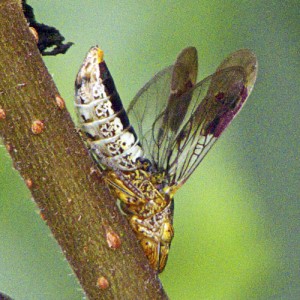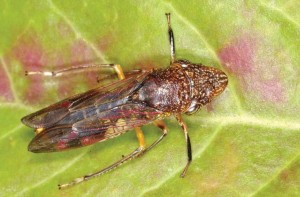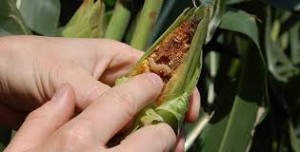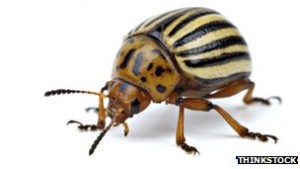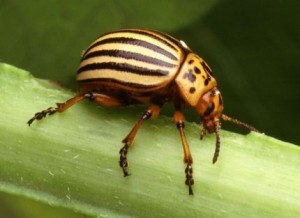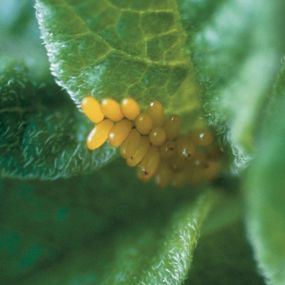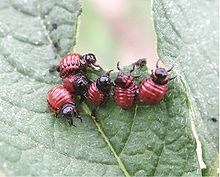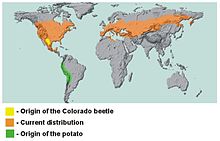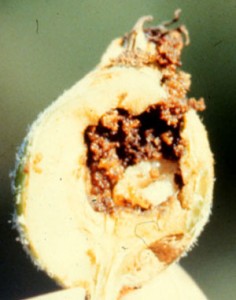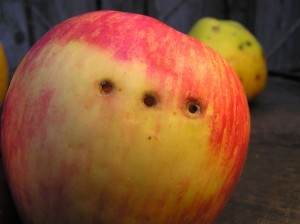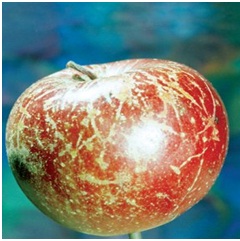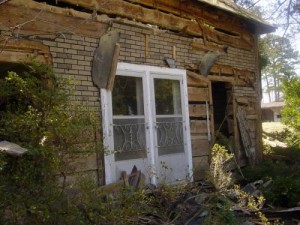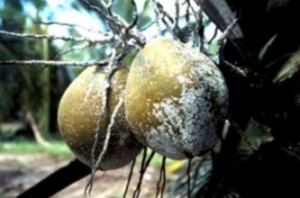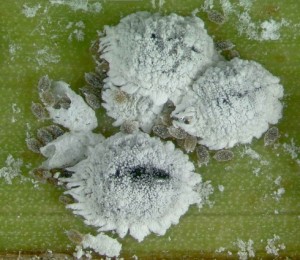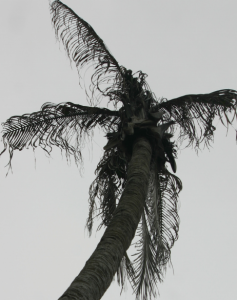 Root maggots are the immature stage, or larvae, of small flies that belong to the insect order Diptera i.e. flies and the family Anthomyiidae. Root maggots occur worldwide. They are short-lived insects. Maggots are not particularly large creatures; their maximum length being 1/4th of an inch. The maggots are – cream colored, elongate with the head end pointed. Root maggots thrive in organic matter.
Root maggots are the immature stage, or larvae, of small flies that belong to the insect order Diptera i.e. flies and the family Anthomyiidae. Root maggots occur worldwide. They are short-lived insects. Maggots are not particularly large creatures; their maximum length being 1/4th of an inch. The maggots are – cream colored, elongate with the head end pointed. Root maggots thrive in organic matter.
Root maggots constitute the most serious annually recurring insect pest problem of vegetable production. They attack all varieties of crucifiers. When root maggot larvae feed on root crops such as turnip, rutabaga, and radish, they leave surface scars and feeding tunnels thus literally scarring the plant. Any feeding scars may render the product unacceptable for market thus causing severe losses. The root is severely damaged. Feeding tunnels make the plant vulnerable to infection by soft-rot bacteria and to secondary infestation by springtails and thrips. Feeding by root maggot larvae on the stem, leaf and flowering crucifers like cauliflower, broccoli, cabbage, brussels sprouts and kohlrabi results in the severe decline in the health of the plant. Young plants may be girdled and may die. Root systems in older plants may be extensively damaged and the taproot may be destroyed completely.
Root maggots attack different crops like cabbage, onion, canola, etc. They are named based on the crops that they target as canola root maggot, cabbage root maggot, onion root maggot, etc.
T he cabbage maggot, Delia radicum, is a sporadic pest of many Cole crops including cabbage, broccoli, cauliflower, Brussel sprouts, turnips, radishes, and other crops of the mustard family. Occasionally, they attack other vegetables such as beet and celery. When cabbage maggots emerge, they immediately start feeding on the roots of the host plant seedlings. Plants are more susceptible to cabbage maggots during a wet, cold spring with most of the damage limited to the early spring plantings. Injury from the second generation in late June or July is usually not severe because the maggots prefer cool, moist conditions and younger, tender plants. Maggots feed on the root hair and can create extensive, slimy tunnels on the root surface and throughout the roots. Larvae feed on roots and tunnel into the taproot, producing brown streaks on the root. The lower leaves of infested plants often turn yellow, with severe damage resulting in arrested plant growth. Feeding damage may also promote disease, causing further stress on the plant. Root maggots and root disease often show up together in the same field.
he cabbage maggot, Delia radicum, is a sporadic pest of many Cole crops including cabbage, broccoli, cauliflower, Brussel sprouts, turnips, radishes, and other crops of the mustard family. Occasionally, they attack other vegetables such as beet and celery. When cabbage maggots emerge, they immediately start feeding on the roots of the host plant seedlings. Plants are more susceptible to cabbage maggots during a wet, cold spring with most of the damage limited to the early spring plantings. Injury from the second generation in late June or July is usually not severe because the maggots prefer cool, moist conditions and younger, tender plants. Maggots feed on the root hair and can create extensive, slimy tunnels on the root surface and throughout the roots. Larvae feed on roots and tunnel into the taproot, producing brown streaks on the root. The lower leaves of infested plants often turn yellow, with severe damage resulting in arrested plant growth. Feeding damage may also promote disease, causing further stress on the plant. Root maggots and root disease often show up together in the same field.
Severe root maggot damage can occur in fields with back to back canola plantations if crop rotation is not followed. Based on average canola prices, the yield losses quantified in the study were equivalent to $108-$140 per acre after only three years of continuous canola. In canola, severe maggot infestations can cause plant wilting, stunting and reduced flowering, decreased seed weight, and lower seed yields. If feeding tunnels are extensive and girdle the root, plant lodging and death can occur. Roots damaged by these maggots are more susceptible to invasion by root pathogens such as Fusarium than intact roots. Yield reductions of the range of 50 and 19 percent from root maggot damage for crops of Brassica rapa L. and B. napus L., respectively, have been reported. In a four-year survey conducted by a team of scientists, of nearly 3000 canola fields across Western Canada, the greatest degree of damage over the largest area was found in central, western and northwestern Alberta, although localized areas with severely damaged roots occurred along the northern edge of the entire Parkland eco region. Soil type can play a part in the degree of root maggot infestation of canola.
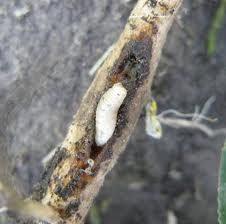 The onion maggot (Delia antique) is one of the most destructive insect pests of onions and related plants. Injured seedlings wilt and die. Larger bulbs may survive some injury but are often poor keepers. Once onion maggots infest an area, they seem to be a problem every year. White onion varieties are more susceptible to attack than other varieties. Stunted or wilting onion plants are the first signs of onion maggot damage. At this time, you may find the maggots in putrid, decomposing onion plants. Light infestations may not kill onions but may make them more susceptible to rots. Onions of all sizes may be attacked, especially in the fall, when cooler weather favors the maggot’s activity. Damaged onions are not marketable and will rot in storage causing other onions to rot.
The onion maggot (Delia antique) is one of the most destructive insect pests of onions and related plants. Injured seedlings wilt and die. Larger bulbs may survive some injury but are often poor keepers. Once onion maggots infest an area, they seem to be a problem every year. White onion varieties are more susceptible to attack than other varieties. Stunted or wilting onion plants are the first signs of onion maggot damage. At this time, you may find the maggots in putrid, decomposing onion plants. Light infestations may not kill onions but may make them more susceptible to rots. Onions of all sizes may be attacked, especially in the fall, when cooler weather favors the maggot’s activity. Damaged onions are not marketable and will rot in storage causing other onions to rot.
Let us look at the following news article about root maggot damage.
Continuous canola can lead to root maggot damage
CONTINUAL DROP Study finds drop in yields significant after the first year
Posted Oct. 5th, 2012
If your rotation is canola, snow, and canola again, you’re setting yourself up for a root maggot infestation.
Insects love it when you grow the same crop year after year, and root maggots and canola are no exception, University of Alberta entomologist Lloyd Dosdall told attendees at a recent Alberta Canola industry update seminar.
Dosdall was part of a research team that examined how canola rotation — or the lack of it — affects crop damage, yield, and seed quality. The study examined 13 different treatments done across Western Canada at five different sites from 2008 to 2011.
Several sites were continuously cropped with canola, while others had a canola-wheat-canola rotation or only had canola in one of the three years. At the end of the season, researchers examined root damage to determine the severity of root maggot infestation.
“The damage to canola that was grown continuously was more severe than when canola was rotated,” said Dosdall.
Root maggot larvae overwinter in soil and the study found the damage they cause increased every year.
“We had the highest yields in the first year of continuous canola, and then they just dropped down significantly in the following two years,” he said.
Dosdall said the loss from continuous cropping ranged from a loss of $280 to $380 per hectare.
Hence to help alleviate or else completely eradicate the infestation we C Tech Corporation provide you with the best effective solution Combirepel™.Combirepel™ is an anti-insect aversive developed on the grounds of green chemistry and technology.
Our product works on the mechanism of repellency. It temporarily inhibits the mating cycle of the insects. The product impairs the ability of the insects to reproduce, that is the insects will not lay eggs or the laid eggs will be infertile. The product causes feeding disruption in an insect by triggering an unpleasant reaction within the insect which might try to feed on the application. The product temporarily blocks the reproduction system of the insects by hindering the release of the vital hormones for growth.
Combirepel™ is thermally stable and does not degrade on exposure to heat and sunlight. It does not kill or harm the insect but repels them. It does not volatilize and does not degrade the soil. It is RoHS, RoHS2, ISO, REACH, APVMA, NEA compliant and FIFRA exempted.
Combirepel™ is an eco-friendly product which acts as an aversive to repel the pesky insects like roaches. Combirepel™ do not kill the targeted as well as non-targeted species but just repel them causing no harm any to human and environment.
Combirepel™ is available in the form of the masterbatch, liquid concentrate, and lacquer. Our Combirepel™ masterbatch can be used in polymer base applications like wires, cables, irrigation pipes, polymeric vessels, and other various applications.
Combirepel™ liquid concentrate can be mixed in the paints to cover the areas like cracks and crevices of walls and hidden places where the roaches tend to survive.
Combirepel™ lacquer is the topical coating to cover the places like bathrooms, cupboards, steam tunnels, etc.
Hence we provide you with the best effective solution.
Contact us as technical.marketing@ctechcorporation.com to get solution on pest nuisance.
Also, visit our websites:
http://www.ctechcorporation.com/
http://www.rodrepel.com/
http://www.termirepel.com/
http://www.combirepel.com/
Follow our Facebook pages at:
1] https://www.facebook.com/Combirepel-411710912249274/
2] https://www.facebook.com/Termirepel-104225413091251/
3] https://www.facebook.com/Rodrepel-120734974768048/
Follow us on our Twitter pages at:
1] https://twitter.com/rodrepel
2] https://twitter.com/termirepel
3] https://twitter.com/combirepel




